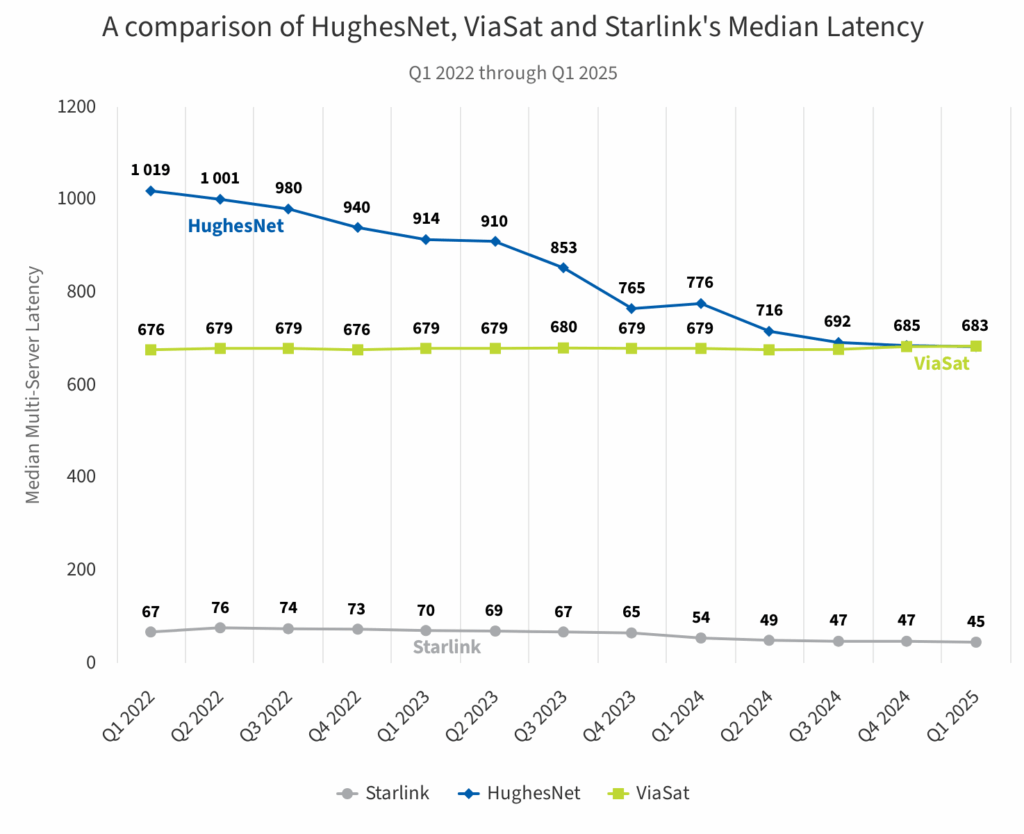Ookla analysis shows better latency for HughesNet, but Starlink LEO still outshines other satellite offerings
When it comes to space-based connectivity, there are no work-arounds for the laws of physics — and geostationary satellites are really far away. New analysis from Ookla shows that while speeds from GEO providers have increased over the last few years, they are struggling to compete on latency, uplink and overall speed with new options like LEO operator Starlink, and losing customers as a result.
HughesNet’s median multi-server latency still dropped significantly in the past few years, from 1,019 milliseconds in the first quarter of 2022 to 683 ms in the first quarter of this year. Viasat, meanwhile, held fairly steady at 676 ms in Q1 2022 and 684 ms in the first quarter of 2025. Comparatively, Starlink’s latency in the first quarter of this year was just 45 ms.

On the upside, GEO providers have essentially doubled their downlink speeds since the early 2020s. For HughesNet, that means a jump from median download speeds of 20.87 Mbps in early 2022 to 47.79 Mbps this year. Viasat made a roughly similar improvement, from 25.18 Mbps to 49.12 Mbps over the same time interval. They still both trail well behind Starlink, which has been aggressively expanding its satellite constellation with new hardware (and cellular direct-to-device capabilities) and had a median download speed in Q1 2025 of more than 100 Mbps, per Ookla.
Interestingly, though, Ookla noted that most GEO users actually experience significantly higher speeds than the median numbers would suggest. At the 75th percentile of users, Ookla found that download speeds weren’t actually that far off from Starlink, seeing nearly 96 Mbps downlink speeds. Viasat users in the 75th percentile clocked speeds at 78.55 Mbps.
Uplink speeds are pretty dismal, though. HughesNet bumped up its median upload speed from 2.87 Mbps to 4.44 Mbps in the past three years, but Viasat actually saw worsening uplink performance, dropped from 3.06 Mbps to 1.08 Mbps. Both compare unfavorably to Starlink’s median uplink speed at 14.84 Mbps as of the first quarter of 2025.

Ookla also noted that both GEO providers have been steadily losing customers in the past few years, with HughesNet’s subscriber base dropping from 1.22 million in 2022 to 853,000 in Q1 2025, and Viasat’s subscribers plummeting from 590,000 at the end of 2021 to fewer than 189,000 this year.
The satellite competitive landscape is set for another shake-up with the recent launch of Amazon’s first commercial Kuiper satellites. Under Federal Communications Commission (FCC) rules, Amazon is required to launch half of its anticipated LEO network — more than 1,600 satellites — by mid-2026.
Read the full analysis from Ookla here.
In other test news:
-Cable broadband equipment manufacturer Harmonic is touting a recent demonstration at a CableLabs Interop event where it was able to deliver DOCSIS 4.0 downstream speeds of 14 Gbps over a multi-vendor network, exceeding a benchmark target of 10 Gbps.
The Interop testing event included Harmonic’s cOS broadband platform and Pebble-2 DOCSIS 4.0 Remote PHY Device, which the company said is the first to provide both Full Duplex (FDX) and Frequency Division Duplex (FDD) in DOCSIS.
“This major milestone demonstrates that our cOS platform is primed to support DOCSIS 4.0 rollouts, enabling the standard’s full set of downstream and upstream speed options with fiber-like symmetric multigigabit speeds,” said Asaf Matatyaou, SVP of product at Harmonic.
–Teledyne LeCroy has introduced a new software option for USB Gen T testing on its Voyager M4x and M480x analyzer/exercisers. Gen T specs enable faster performance for USB interconnects. The new software option enables “comprehensive functional and compliance testing for next-generation USB4 Gen T devices,” the test company said, and it includes access to Gen T compliance scripts that were co-developed with the USB Implementers Forum (USB-IF).
Teledyne LeCroy noted that its early testing software is available before commercial devices have been released, reducing time-to-market for future USB4 products.
-Instrument company GW Instek is boosting its offerings aimed at the industrial manufacturing in the semiconductor, AI server and electric vehicle markets with an expanded digital multimeter series and data acquisition system. The company said that its solutions can reduce testing time by up to 50%.
-Testing and certification company Dekra recently celebrated its 100-year anniversary.

